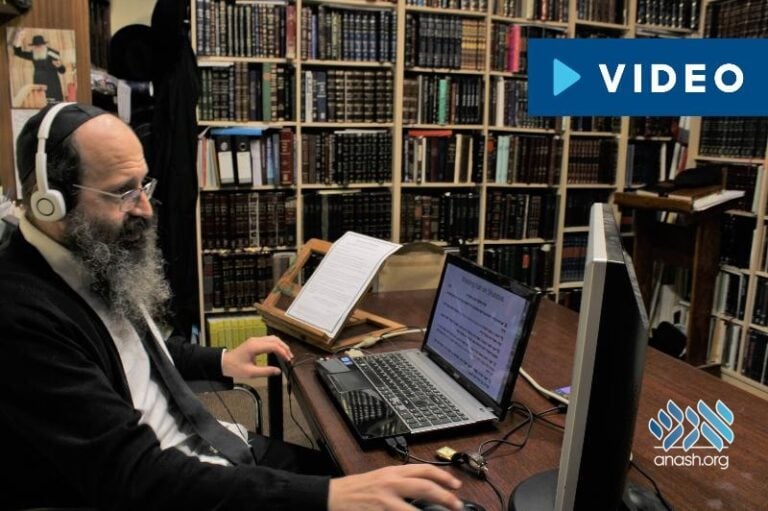ב׳ אייר ה׳תשפ״א | April 13, 2021
Watch: Panorama of Halacha
Anash.org feature: A weekly shiur by Dayan Levi Yitzchok Raskin, Rov of Anash in London, explores interesting Torah questions and halachic dilemmas.

Anash.org feature: A weekly shiur by Dayan Levi Yitzchok Raskin, Rov of Anash in London, explores interesting Torah questions and halachic dilemmas.
The following issues are discussed by Rabbi Raskin in this week’s episode:
- May a peeler be used on Shabbos to peel an apple? [1]
- What about Pesach, when we avoid eating unpeeled produce? [2]
- Despite our caution to the extreme to avoid wetting Matzo during Pesach, on the 8th day of Pesach many of us did cook Gebroktz. Do the utensils involved need to be kashered before next Pesach? [3]
- During Pesach we made some kind of sweet, combining mashed banana and crushed nuts. Some remained after Pesach, but it had become mushy, so we mixed in some rolled oats. Is the brocho now Mezonos or Shehakol? [4]
- A kazayis of chocolate cake is 30% sugar. Is the after-brocho Al haMichya or Borei Nefoshos? [5]
- Many Jewish communities in the Former Soviet Union do not have their own dedicated burial grounds. In order to discourage cremation, we have been assisting Jewish burials within non-Jewish cemeteries. Is this allowed? [6]
- We have a room that was a bathroom, but the porcelain has been removed and it is now used as a storeroom. Is a mezuzah required? [7]
- When the Sefer Torah is brought out on Yomtov, we recite the 13 Attributes of Divine Mercy, followed by Ribono Shel Olam. When Yomtov occurs on Shabbos, the 13 Attributes aren’t recited. What about Ribono Shel Olam? [8]
- Naming a child after a deceased parent is seen as a virtue. [9] But when I call that child by name, am I not compromising my respect to my parent? [10]
[1] בשמירת שבת כהלכתה פ”ג ס”ל נוטה להקל, עפ”ד האגלי טל. אבל בס’ שבת כהלכה [ח”ב פי”ג ס”ט וילך] מחמיר.
[2] בשבת כהלכה החמיר יותר לגבי איסטניס. לכאורה בפסח כלנו איסטניסים.
[3] כלים שנאסרו במשהו חמץ בתוך הפסח, לרוב הפוסקים אין צריך להכשירם לפסח הבא. אבל המנהג להכשירם – ס’ הגעלת כלים פ”ג סי”ג; פסקי תשובות סי’ תמז סק”ג. באוצר מנהגי חב”ד ע’ רכד מובא שבבית כ”ק אדמו”ר מוהרש”ב השתמשו באחש”פ לשרוי’ באותם הכלים של כל הפסח. וע”ש מנהגי עדות שונות בזה, אם סמכו דוקא על יישון י”ב חודש.
[4] סדר ברכת הנהנין פ”ג ה”ג.
[5] בסדר ברכת הנהנין פ”ג ה”ב כתב שכשיש כזית בכא”פ, ברכתו מזונות. אבל בפ”ח ה”ג הביא י”א עד שיאכל כל הפרס. שו”ע סי’ רח ס”ט בשם אבודרהם. מג”א שם בסוף הסימן.
[6] ביו”ד סי’ שסב ס”ה שאין לקבור רשע אצל צדיק. בשו”ת מנחת אלעזר ח”ב סי’ מ”א מצריך מחיצה מלמטה. וי”ח.
[7] משנה ברורה סימן פד סק”ג. שכל טוב סי’ רפו ס”ק צה.
[8] התוועדויות תשנ”ב ח”א ע’ 109. שערי תשובה או”ח סי’ תפח.
[9] זיו השמות פ”ד. וראיתי מי שהעיר שהשם ‘נדב’ לבכור אהרן נקרא על שם אבי אמו, עמינדב.
[10] פסקים ותשובות יו”ד סי’ רמ ס”ק יב.



How do we submit questions
According to the theory that when using flour from Kitniyos (etc.) one would need to eat the entire Kezayis of actual wheat flour in order to say Birkas Hamazon then it would follow that in Hilchos Pesach 453:7 he would be required to eat the entire Kezayis of actual wheat flour in order to fulfill the obligation of Matzah?
Yet even according to the most strict opinion there if there’s a majority of wheat flour all you need to have is a Kezayis of that mixture!
The sentence בסדר ברכת הנהנין פ”ג ה”ב כתב שכשיש כזית בכא”פ, ברכתו מזונות is a mistake because there he only requires כזית בכא”פ in order to say על המחיה. However, you would need ממשות in order to say מזונות.